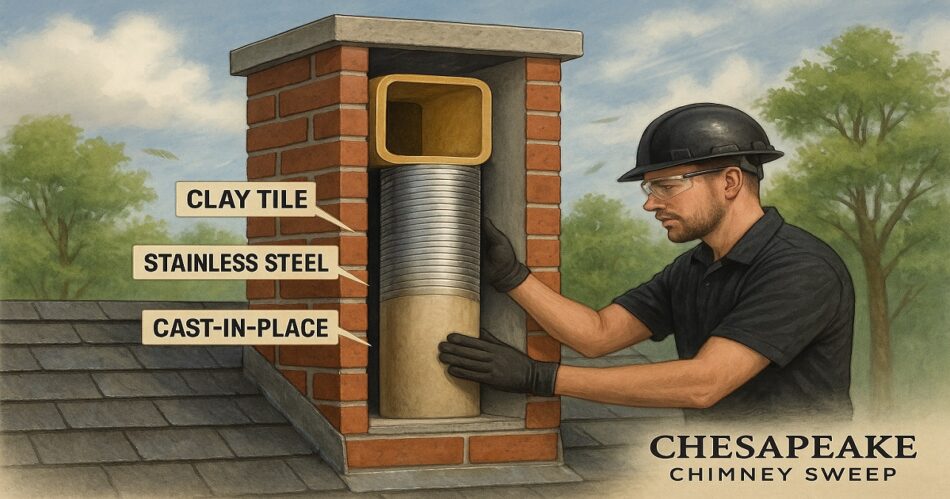Chesapeake’s weather likes to keep everyone guessing. One day it’s chilly and damp, the next it’s warm and muggy, and winter storms can roll in with little warning. If you have a fireplace, you know that taking care of your chimney isn’t just about keeping things cozy—it’s about safety, efficiency, and making sure your house stays in great shape. When it comes to lining your chimney, the material you pick really makes a difference, especially in a place where the climate can be so unpredictable. Let’s explore the best options, what makes chimney liner stand out, and how to choose what’s right for your home.
“The right chimney liner isn’t just about the material—it’s about peace of mind every time you light a fire.”
Key Features: What to Look For in a Chimney Liner
Before diving into which liner suits Chesapeake’s mix of rain, cold snaps, and humidity, let’s talk about what features matter most. A good chimney liner should handle rapid temperature changes without cracking, resist the moisture that Chesapeake’s air brings, and last for many years with minimal fuss. Flexibility is another plus, especially if your chimney isn’t perfectly straight. And of course, it should stand up to the type of fuel you use—wood, gas, or oil. Whether you’re after something that will last a lifetime or just want an affordable fix, knowing these basics will help narrow down your choices.
| Material | Durability | Weather Resistance | Upfront Cost | Maintenance |
|---|---|---|---|---|
| Stainless Steel | 20+ years | Excellent (handles moisture & temp swings) | Moderate | Low |
| Clay Tile | 15–20 years | Good (can crack in freeze/thaw cycles) | Low | Medium |
| Ceramic | 20+ years | Very Good (resists acids, moisture) | High | Low |
| Aluminum | 5–10 years | Poor (not for wood or oil, rusts easily) | Low | High |
Safety First: Protecting Your Home and Family
When you think about safety, your chimney liner is the unsung hero. In Chesapeake, where dampness can sneak in and cold weather can cause brick to shift, having a liner that doesn’t corrode or crack is essential. Stainless steel is popular because it shrugs off moisture and stands strong against creosote buildup—a common problem when burning wood in a damp climate. Ceramic is another safe bet, especially for newer homes or high-end installations, thanks to its resistance to acids and heat. Clay tile, while traditional, can struggle with the area’s freeze/thaw cycle, sometimes leading to hidden cracks that cause dangerous leaks. No matter the material, a damaged liner can let toxic gases seep into your home, so it’s worth choosing one that matches Chesapeake’s climate challenges.
Cost: Balancing Budget and Longevity
Let’s be honest—everyone wants something that lasts, but not everyone wants a huge bill. Stainless steel lines up well here. It’s not the cheapest, but it isn’t the most expensive either, and you get decades of protection. Clay liners save money upfront but may cost more in the long run if they crack and need repair. Ceramic liners are top-of-the-line, but their price tag reflects their durability and low maintenance. Aluminum is tempting for gas-only chimneys, but the Chesapeake weather can wear it out quickly, leading to more frequent replacements. When weighing your options, think about how often you want to deal with repairs—sometimes spending a bit more now saves a lot of hassle later.
Emergency Service: When the Unexpected Happens
Chesapeake’s fast-changing weather means you might need help in a hurry. A storm can knock debris into your chimney, or a surprise cold snap can reveal cracks you didn’t know were there. Stainless steel liners often make emergency repairs easier since they can be quickly installed in most chimneys, even older or oddly-shaped ones. Clay tiles, on the other hand, can be tricky and time-consuming to fix, especially if the damage is deep inside the chimney. Ceramic liners are tough but may require specialty parts if they get damaged. When choosing a liner, keep in mind how easy it will be to get back up and running if something goes wrong—nobody wants to be stuck without heat in the middle of a Chesapeake winter.
Frequently Asked Questions about Chimney Liner
Q. Which chimney liner material lasts the longest in Chesapeake?
Stainless steel and ceramic liners both offer excellent lifespans (often 20 years or more), even with the area’s unpredictable weather.
Q. Can I install a chimney liner myself?
While it might look easy in videos, chimney lining requires special tools and know-how. For safety and insurance reasons, hiring a professional is always recommended.
Q. What happens if I don’t replace a damaged chimney liner?
Ignoring a cracked or corroded liner can allow dangerous gases and heat into your home, leading to potential health risks and even house fires.
Q. How often should I have my chimney checked in Chesapeake?
Once a year is the standard advice. Given Chesapeake’s wet and windy climate, a check-up before every burning season is a smart move.
Final Thoughts: Picking the Right Chimney Liner for Chesapeake
Living in Chesapeake means dealing with whatever the skies send your way, and your chimney liner needs to keep up. Stainless steel comes out on top for most homeowners thanks to its toughness, low upkeep, and ability to handle the area’s wild weather. Ceramic is a great option if you want something that’s both durable and cutting-edge, while clay remains budget-friendly for those willing to keep an eye on it. No matter what you choose, treat your chimney liner as a long-term investment in your comfort and safety. After all, nothing beats the peace of mind of a crackling fire on a chilly Chesapeake night, knowing your home is protected from the inside out.
Read More: Chesapeake Chimney Sweep









